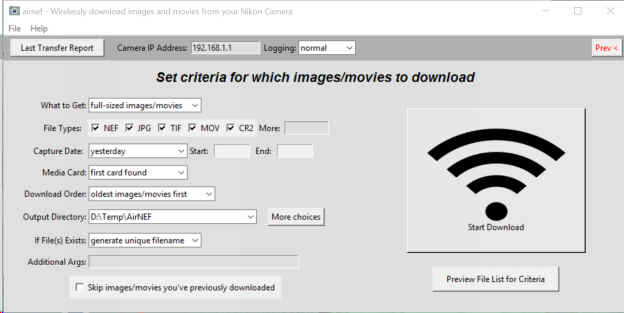|
|
Airnef
by Chris Taylor
If you own a Nikon camera with built-in
or plug-in WiFi, you may be somewhat disappointed with
the level of WiFi support. Nikon has a somewhat anemic Wireless
Mobile Utility that allows limited remote control
for taking photos and transferring them from the camera
to Android or iOS devices.
But what if you have a laptop computer and want to
transfer your photos from the camera to the laptop? Or a
Windows tablet? Or a Linux computer? Nikon’s utility
won’t help you.
There are a few ways to transfer files from the camera to
the computer. The best option is to pop the camera’s
memory card into the card slot on your laptop.
But my Surface Pro 2 only has a micro-SD card slot and my
camera uses full-sized SD cards. The second option is to
plug an external card reader into the USB port on the
computer.
If you don’t happen to have an external card reader,
a third choice is to plug the camera into the computer
using a USB cable.
There may be some circumstances where none of those
options work for you.
Airnef is a free, open-source utility for Windows, Linux
and Mac OS. It allows you to connect to your camera and
transfer photos and videos over a WiFi connection.
Before you proceed, make sure you look back at my
recommendations above for transferring photos. If any of
these can work for you, they provide simpler and much
faster methods.
Okay, you really, really need to transfer photos
from your camera over WiFi. Head over to
http://www.testcams.com/airnef/
and download the appropriate version of Airnef.
When you start Airnef, you are given two transfer
options. If you choose the first, you select the images
to transfer directly on the camera. You then specify a
folder on your computer to store the copies and how you
want name conflicts handled. This method works really
well if you have just a few images or videos you want to
transfer.
If you want more of a bulk transfer, the second Airnef
option is a better choice – using the desktop
application to select which files to transfer. With this
method, you have many options;
- Full images, small or large thumbnails;
- Choose from 5 predefined file
types or specify a custom file extension;
- Choose a subset by date taken,
including choices like today, yesterday, past
week or a date range;
- Choose a card slot (for cameras
with multiple card slots)
- Choose the directory to store the
copies;
- Specify how File exists
conditions are handled;
- Option to skip images you have
already downloaded;
- Preview what will be downloaded
with the chosen options.

Airnef has built-in fault tolerance. If
the connection drops unexpectedly, once you re-establish
the connection, it picks up where it left off, even if
that’s in the middle of a file. This is a nice
feature, especially if a transfer of a 2GB video file is
interrupted at 1.9GB!
Earlier in the article I mentioned how just about any
other method for transferring photos and videos is
preferred. The reason is speed. It is not the fault of
Airnef – file transfers over WiFi are sloooowww.
I transferred 158 files totalling 3.4 GB using Airnef. It
took over 24 minutes for an average transfer rate of 2.34
MB/sec. Using the card reader on my computer took just 6
minutes – less than one quarter the time. And it
didn’t chew through the battery on my camera for 24
minutes!
A video on YouTube does a good job of highlighting how to
use Airnef.
Airnef also works with WiFi enabled Canon cameras.
Although Canon’s EOS utility can transfer photos to
a Windows computer, you may find the additional options
in Airnef useful.
Bottom
Line:
Product name: Airnef v1.0
Free and open source for Windows, Linux, Mac OS
http://www.testcams.com/airnef/
Originally published: April, 2016
top of page
|
Archived Reviews
A-J
K-Q
R-Z
The opinions expressed in these reviews
do not necessarily represent the views of the
Ottawa PC Users' Group or its members.
|